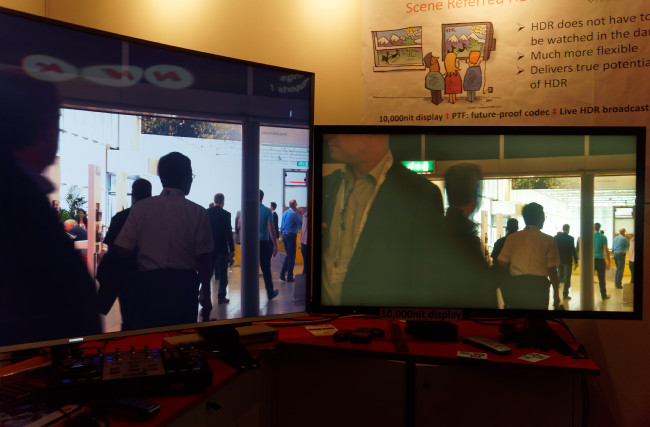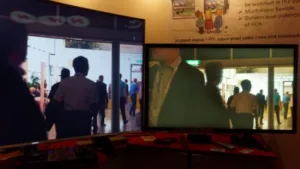One of the most intriguing displays in the Future Technology Zone at IBC was a booth that was being manned by Professor Alan Chalmers from the University of Warwick and Domenico Toffoli, Head of R&D from Sim2 in Italy. They were showing a live demonstration of a 10,000 cd/m² monitor, made by Sim2 and running using technology developed by Chalmers and some of his students. He feels it is better, rather than using the PQ curve, to use a simple Power Transfer Function (PTF), as the PQ curve is really only designed to work up to 4,000 cd/m². The use of a power transfer function allows much higher brightness and at the event the demo monitor was measured at 10,500cd/m².
 Sim2’s 10K cd/m² monitor – note the highlight details. Image:Meko
Sim2’s 10K cd/m² monitor – note the highlight details. Image:Meko
The monitor has 2202 zones (and LEDs) and uses 12 bit modulation, with a 10 bit panel. The colour gamut of the panel was Rec. 709 and its a 47″ commercial grade IPS panel. Previously, the brightest display that Sim2 had made was 6,000 cd/m². The monitor on show has air cooling and uses five fans to keep temperatures under control.
Chalmers told us that the PTF is scene-referred, so the system effectively allows the camera to “capture everything”, as camera sensors are getting to the point where they can capture 15 F Stops (our notes say that the demo system had around 17.5 stops) or more, which can then be converted down for display. The PTF can support up to 30 F Stops. The PTF method maps real-world luminance into a 12-bit luma space and preserves chrominance in 8-bit u’v’ chroma channels similar to LogLUV.
One of the advantages of the proposal around PTF is that it can be encoded and decoded very fast, much faster than PQ – the group has shown >300 fps decoding and is relatively easy to implement in FPGAs and GPUs. It claims to be 1.5 times faster than a lookup system for PQ.
Analyst Comment
One of the key points about PQ is that the differences between adjacent code numbers should be smaller than is visible to the human eye, based on the work by Peter Barten on sensitivity. Chalmers pointed out that this work was done on a very limited sample and conditions and is probably worth revisiting from a research point of view. However, he also said that while the PQ curve does work well on uncompressed data, the process of compression and decompression can distort the code values, so although the PTF, from the get go, is capable of producing levels that allow visible banding, his testing shows that after compression, it is no worse than PQ.

